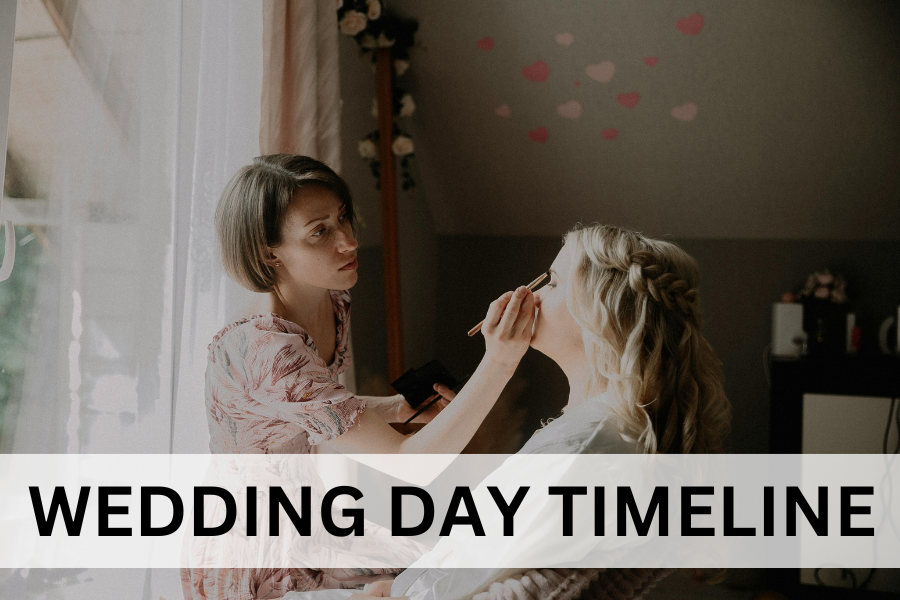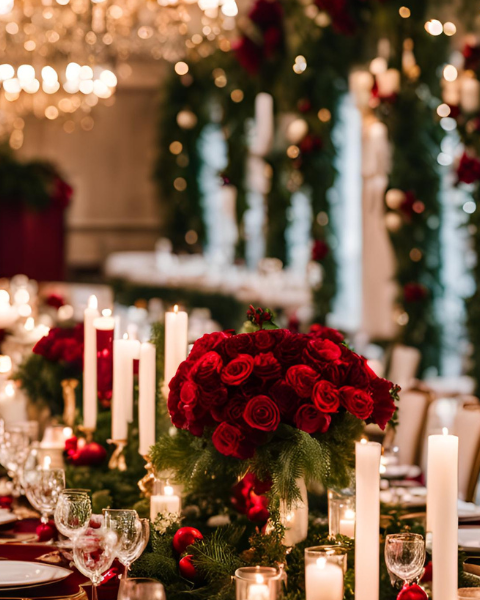Trying to figure out the flow of your wedding? This is the best stress-free wedding day timeline you need!

Your wedding day is one of the most important and memorable days of your life, and the last thing you want is for it to be filled with unnecessary stress. One of the best ways to keep things calm and organized is by creating a well-structured wedding day timeline. With a little planning, you can ensure that everything runs smoothly, leaving you to enjoy each special moment.
Here’s a guide to planning a stress-free wedding day timeline that will keep you, your vendors, and your guests on the same page.
How to Plan a Stress-Free Wedding Day Timeline
1. Start Early—Build in Buffer Time
If there’s one rule to follow when creating your wedding day timeline, it’s to start early and give yourself plenty of buffer time. Things will likely take longer than expected—whether it’s hair and makeup, greeting guests, or moving from one location to another.
- Tip: Aim to start your day earlier than you think you’ll need. It’s better to have extra time than to feel rushed. This also gives you some wiggle room if any last-minute issues pop up.
A typical wedding day timeline might start with hair and makeup around 8:00 or 9:00 a.m. for a 3:00 p.m. ceremony, but always check with your vendors for their recommendations!
2. Talk to Your Vendors and Wedding Coordinator
Your vendors have likely worked hundreds of weddings and are pros at managing the flow of the day. Consult with themwhen creating your timeline, as they can provide valuable insight on how much time is needed for each part of the day.
- Photographers: They will need specific time for getting-ready photos, couple portraits, bridal party pictures, and family photos. Let them know what shots are most important to you so they can schedule accordingly.
- Hair & Makeup Artists: Ask your stylists how long it will take to complete your look, and be sure to include any additional time if your bridal party is getting their hair and makeup done, too.
- Wedding Coordinator: If you have a planner or day-of coordinator, they will be your best resource in building a realistic, stress-free timeline.
Tip: Work closely with your coordinator to ensure the timeline is feasible and that all vendors know the plan.
3. Prioritize “First Look” and Photo Time
A “first look” is a private moment between the bride and groom before the ceremony. Many couples choose this option because it allows for a more relaxed photo session earlier in the day, reducing pressure after the ceremony.
- First Look: Plan around 20–30 minutes for your first look, including travel time if you’re doing it in a different location.
- Photos: If you want formal photos of you and your partner, family, and bridal party, budget around 1–2 hours for pictures, depending on the size of your group and the locations involved.
Tip: Taking the bulk of your photos before the ceremony can save time later, allowing you to join your guests sooner at the reception.
4. Ceremony Start Time and Length
The ceremony is the focal point of the day, so plan it with care. The ceremony length can vary depending on your traditions or any additional rituals you may include.
- Average Length: Most ceremonies last around 20–30 minutes, but factor in any special moments like readings, unity ceremonies, or a musical performance that could extend the time.
- Guest Arrival: Make sure to allow plenty of time for your guests to arrive, get settled, and be seated before the ceremony begins. Plan for guests to start arriving around 30 minutes before the ceremony.
Tip: Keep in mind travel time if your ceremony and reception are at different locations and account for parking and traffic.
5. Cocktail Hour Timing
Cocktail hour is a great way to entertain your guests while you finish any remaining photos or prepare for your reception. Typically, cocktail hour lasts about 60 minutes, but you can extend it if needed.
- During this time: Use it to sneak away for some “just married” photos or simply to enjoy a moment together before diving into the reception.
- Serving Drinks and Snacks: Make sure your guests have enough drinks and appetizers to stay happy and comfortable while you wrap up the final moments before the big party begins!
Tip: Let your vendors know if there’s anything special happening during cocktail hour (like a signature drink or live music) so they can incorporate it into their own timelines.
6. Reception Flow: Dinner, Toasts, and Dancing
The reception is where the fun happens, but having a structured flow helps keep things on track. Here’s a typical reception timeline:
- Grand Entrance: After cocktail hour, plan for your grand entrance, where you and your bridal party make a formal introduction. This usually takes about 10–15 minutes.
- Dinner: Depending on the serving style (plated or buffet), dinner usually lasts around 45 minutes to 1 hour.
- Toasts: Allow 5–10 minutes per speech, typically from the maid of honor, best man, and possibly parents or other close family members.
- First Dance and Parent Dances: Plan around 15–20 minutes for your first dance and any parent dances.
- Dancing and Partying: Once dinner and the formal dances are done, the dance floor usually opens up for 2–3 hours of celebration. Make sure your DJ or band knows your must-play songs to keep the energy high!
Tip: Consider scheduling events like cake cutting, bouquet tossing, or any special performances early in the night to ensure they happen before guests start to leave.
7. Plan for the Exit
Whether you’re having a grand exit with sparklers, a confetti toss, or a classic car getaway, plan the timing of your send-off to ensure your photographer and videographer are ready to capture the moment.
- Farewell: Many couples plan their exit around 10:00 or 11:00 p.m., depending on the venue’s curfew or any noise ordinances. Be sure to give your vendors a heads-up on the time so everyone is prepared.
Tip: If you don’t want to leave the party early, consider staging your exit photo earlier in the evening so you can relax and enjoy the rest of the reception.
Final Thoughts on Creating Your Wedding Day Timeline
When planning your wedding day timeline, the key is to be realistic about how long things take and build in extra time for any unexpected delays. Communication with your vendors and wedding party is crucial to ensuring that everyone is on the same page and knows what’s expected of them. By staying organized and preparing in advance, you’ll be able to enjoy a smooth, stress-free wedding day that’s filled with love, laughter, and beautiful memories.
Are you working on your wedding day timeline? Share your tips or questions in the comments below—we’d love to hear from you!
This post was all about how to have a stress-free wedding day timeline.
Other posts you might like:



